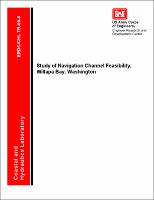Please use this identifier to cite or link to this item:
https://hdl.handle.net/11681/7468Full metadata record
| DC Field | Value | Language |
|---|---|---|
| dc.contributor | Evans-Hamilton, Inc. | - |
| dc.contributor | Pacific International Engineering | - |
| dc.contributor.author | Kraus, Nicholas C. | - |
| dc.contributor.author | Abbott, Charles E. (Charles Edward), 1939- | - |
| dc.contributor.author | Arden, Hiram T. | - |
| dc.contributor.author | Bermudez, Hugo | - |
| dc.contributor.author | Bratos, Steven M. | - |
| dc.contributor.author | Brown, Mitchell E. | - |
| dc.contributor.author | Ebersole, Bruce A. | - |
| dc.contributor.author | Fenical, Scott | - |
| dc.contributor.author | Fitzgerald, Ken, 1955- | - |
| dc.contributor.author | Giles, Suzanne L. (Suzanne Lynn) | - |
| dc.contributor.author | Hands, Edward B. | - |
| dc.contributor.author | Kurrus, Keith | - |
| dc.contributor.author | Militello, Adele | - |
| dc.contributor.author | Phillips, Shane Michael | - |
| dc.contributor.author | Scheffner, Norman W. | - |
| dc.contributor.author | Seabergh, William C. | - |
| dc.contributor.author | Shepsis, Vladimir | - |
| dc.contributor.author | Smith, Jane McKee | - |
| dc.contributor.author | Titus, Carol | - |
| dc.date.accessioned | 2016-05-06T14:32:49Z | - |
| dc.date.available | 2016-05-06T14:32:49Z | - |
| dc.date.issued | 2000-04 | - |
| dc.identifier.uri | http://hdl.handle.net/11681/7468 | - |
| dc.description | Technical report | - |
| dc.description | The navigation channel reliability monitoring and evaluation study for Willapa Bay, Washington described in this report was performed by the U.S. Army Engineer Research and Development Center, Coastal and Hydraulics Laboratory for the U.S. Army Engineer District, Seattle (NWS). The study was established under a Partnering Agreement between the NWS and the Willapa Port Commission for determining the feasibility of maintaining a reliable navigation channel through the Willapa Bay entrance. Willapa Bay is a large estuarine system located on the southern end of the Washington coast. Its spring or diurnal range tidal prism is one of the largest of all inlets on the coast of the continental United States. The shifting channels at the entrance to Willapa Bay make navigation unreliable, and the local port cannot maintain or attract commercial users. Local interests obtained Congressional support to determine if an economical deep-draft channel can be established through the entrance bar. An economical channel implies a route that can be traversed safely under typical waves and tidal currents. The study was conducted in a multi-disciplinary approach involving engineering analysis, field measurements, geomorphologic analysis, and numerical modeling of waves, currents, and sediment transport in evaluation of alternative channel designs. These topics are covered in the main text of the report, with additional details and data compilations contained in appendices. | - |
| dc.publisher | Coastal and Hydraulics Laboratory (U.S.) | - |
| dc.publisher | Engineer Research and Development Center (U.S.) | - |
| dc.relation | http://acwc.sdp.sirsi.net/client/en_US/search/asset/1000619 | - |
| dc.relation.ispartofseries | ERDC/CHL TR ; 00-6. | - |
| dc.rights | Approved for public release; distribution is unlimited. | - |
| dc.source | This Digital Resource was created from scans of the Print Resource | - |
| dc.subject | Cape Shoalwater | - |
| dc.subject | Currents | - |
| dc.subject | Dredging | - |
| dc.subject | Field measurement | - |
| dc.subject | Geomorphology | - |
| dc.subject | Navigation | - |
| dc.subject | Navigation channel | - |
| dc.subject | Sediment Transport | - |
| dc.subject | Washington | - |
| dc.subject | Waves | - |
| dc.subject | Willapa Bay | - |
| dc.title | Study of navigation channel feasibility, Willapa Bay, Washington | - |
| dc.type | Report | en_US |
| Appears in Collections: | Technical Report | |
Files in This Item:
| File | Description | Size | Format | |
|---|---|---|---|---|
| CHL-TR-00-6.pdf | 51.48 MB | Adobe PDF |  View/Open |